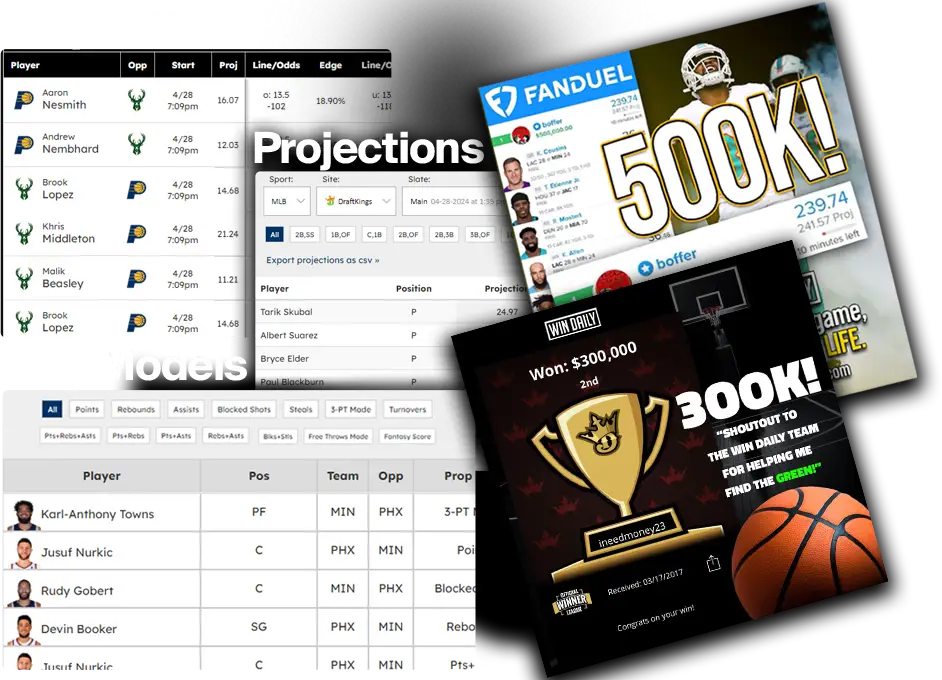Fantasy baseball is a game of statistics, and understanding the key metrics that determine a player’s value is critical to building a winning team. In this article, we’ll provide a detailed glossary of the top 20 MLB statistics for both pitchers and hitters when analyzing fantasy value. All of these statistics are built in to our daily MLB Projection models that are used to build successful lineups for DraftKings and FanDuel.
Pitcher Statistics:
- ERA (Earned Run Average): A pitcher’s earned run average is the average number of earned runs they give up per nine innings pitched. The lower the ERA, the better the pitcher is performing.
- WHIP (Walks plus Hits per Inning Pitched): WHIP is the number of walks and hits a pitcher allows per inning pitched. A lower WHIP indicates that a pitcher is allowing fewer baserunners and is therefore more effective.
- K/9 (Strikeouts per Nine Innings): This statistic measures a pitcher’s ability to strike out batters. A higher K/9 indicates that a pitcher is more likely to get strikeouts and is therefore a more valuable fantasy asset.
- BB/9 (Walks per Nine Innings): BB/9 measures the number of walks a pitcher allows per nine innings. A lower BB/9 indicates that a pitcher has better control over their pitches.
- K/BB (Strikeout-to-Walk Ratio): K/BB is the ratio of strikeouts to walks. A higher K/BB ratio indicates that a pitcher has good control and is more likely to have a low ERA and WHIP.
- FIP (Fielding Independent Pitching): FIP measures a pitcher’s effectiveness in preventing home runs, walks, and hit by pitches while also considering strikeouts. This statistic is useful for evaluating a pitcher’s overall performance, regardless of their team’s defensive ability.
- xFIP (Expected Fielding Independent Pitching): xFIP is similar to FIP, but it adjusts for the fact that some pitchers may be more prone to allowing home runs than others. xFIP uses a league-average home run rate to calculate a pitcher’s expected FIP.
- HR/9 (Home Runs per Nine Innings): HR/9 measures the number of home runs a pitcher allows per nine innings. A lower HR/9 is generally better, as home runs are the most damaging hits a pitcher can give up.
- BABIP (Batting Average on Balls in Play): BABIP is the batting average on balls hit in play, which excludes strikeouts and home runs. A lower BABIP indicates that a pitcher is inducing weaker contact, which can help to limit hits and runs allowed.
- GB% (Ground Ball Percentage): GB% measures the percentage of balls hit in play that are ground balls. A pitcher with a high GB% is more likely to induce ground balls, which can lead to double plays and limit the number of home runs allowed.
Hitter Statistics:
- AVG (Batting Average): AVG is the number of hits divided by at-bats. It is a measure of a hitter’s ability to make contact and get on base.
- OBP (On-Base Percentage): OBP is the percentage of times a player reaches base (hits, walks, hit by pitches) divided by plate appearances. A higher OBP indicates a more patient hitter who gets on base more often.
- SLG (Slugging Percentage): SLG is the total number of bases a player gets from hits divided by at-bats. It measures a player’s power.
- OPS (On-Base Plus Slugging): OPS is the sum of a player’s OBP and SLG. It is a more comprehensive measure of a player’s overall offensive production.
- Isolated power (ISO): Measures a hitter’s raw power by subtracting their batting average from their SLG. It shows how many extra bases a hitter averages per at-bat. A high ISO is generally an indication of a power hitter.
- Strikeout rate (K%): Measures the percentage of plate appearances in which a hitter strikes out. It’s calculated by dividing a player’s total strikeouts by their total plate appearances. A low K% is generally an indication of a better hitter who makes contact more often.
- Walk rate (BB%): Measures the percentage of plate appearances in which a hitter draws a walk. It’s calculated by dividing a player’s total walks by their total plate appearances. A high BB% is generally an indication of a hitter with good plate discipline.
- Stolen bases (SB): Measures the number of times a player successfully steals a base. A high SB total is generally an indication of a player with good speed.
- Ground ball rate (GB%): Measures the percentage of batted balls that are ground balls. It’s calculated by dividing a player’s total ground balls by their total batted balls. A high GB% is generally an indication of a hitter who hits for a higher batting average.
- Fly ball rate (FB%): Measures the percentage of batted balls that are fly balls. It’s calculated by dividing a player’s total fly balls by their total batted balls. A high FB% is generally an indication of a power hitter who hits for extra bases.
Understanding these 20 key pitcher and hitter statistics can greatly improve your ability to analyze players for fantasy baseball purposes.






